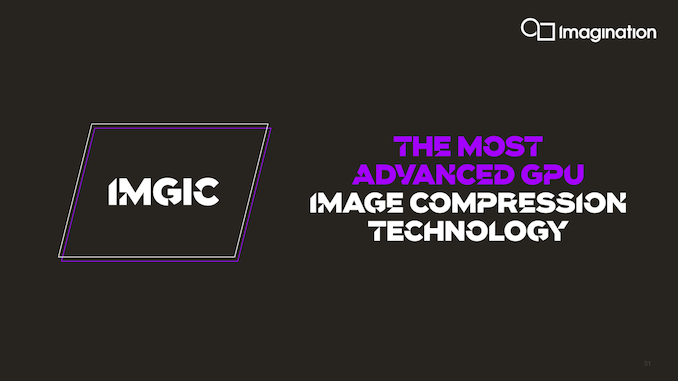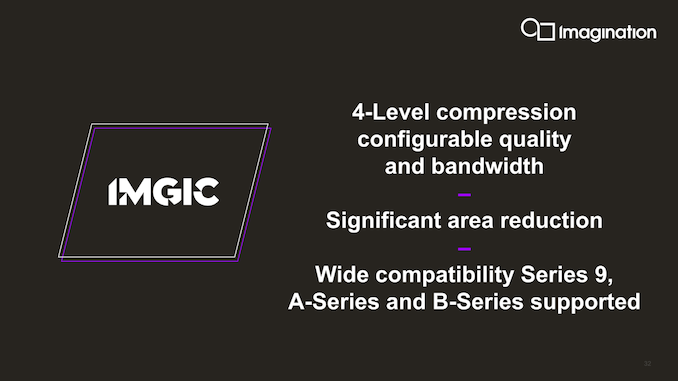Imagination Announces B-Series GPU IP: Scaling up with Multi-GPU
by Andrei Frumusanu on October 13, 2020 4:00 AM EST- Posted in
- GPUs
- Imagination Technologies
- SoCs
- IP
Introducing IMGIC - A better frame-buffer compression
Besides the multi-GPU scalability, another big feature introduction to the B-Series is the addition of a completely new image compression algorithm, simply dubbed IMGIC, or Imagination Image Compression.
Compression is an integral part of modern GPUs as otherwise the designs would simply be memory bandwidth starved. To date, Imagination has been using PVRIC to achieve this. The problem with PVRIC was that it was a relatively uncompetitive compression format, falling behind in data compression ratio compared to other competitor techniques such as Arm’s AFBC (Arm Frame-Buffer Compression). This resulted in IMG GPUs using up more bandwidth than a comparable Arm GPU.
IMGIC is a completely new and redesigned compression algorithm that replaces PVRIC. Imagination touts this as the most advanced image compression technology, offering extreme bandwidth savings and a lot more flexibility compared to previous PVRIC designs. Amongst the flexibility aspect of things, IMGIC can now work on individual pixels instead of just smaller tiles or pixel groups.
Furthermore, the new algorithm is said to be 8x simpler than PVRIC, meaning the hardware implementation is also much simplified and achieves a significant are area reduction.
The new implementation gives vendors more scaling options, adding compression ratios down to a lossy 25% for extreme bandwidth savings. SoC vendors can use this to alleviate bandwidth starved scenarios or QoS scenarios where other IPs on the SoC should take priority.
Overall, the B-Series now offers a 35% reduction in bandwidth compared to the A-Series and previous generation Imagination GPU architectures, which is a rather large improvement given that memory bandwidth is a costly matter, both in terms of actual silicon cost as well as energy usage.














74 Comments
View All Comments
Threska - Wednesday, October 14, 2020 - link
"The MGPU seems like it will be the future of gpu computing, but right now putting multiple slabs of silicon together and efficiently connecting them is expensive and power hungry which is undesirable."https://www.digitaltrends.com/computing/google-sta...
lightningz71 - Tuesday, October 13, 2020 - link
Judging by their past performance with respect to drivers for windows platform systems, I wouldn't touch their desktop products with a ten foot pole until they have thoroughly demonstrated a willingness to:Provide a set of fully functioning drivers
Provide regular updates to those drivers to address bugs and odd behavior
Provide at the absolute least some framework for FOS drivers to be built for Linux
Provide a driver whad for standard linux desktops
Continue to provide these things for a period of several years
Because, up until now, they've done none of the above. Their last desktop product was an integrated gpu for Intel on an early Atom product. They, and Intel, promptly abandoned the product within months of releasing it, and never provided a single functional driver for the very next edition of Windows that was released within six months of the release of that processor. The drivers that were released for the existing windows version had rather basic functionality, were still buggy, and offered no useful video acceleration for any (at the time) modern video compression protocol.
So, they can release it all they want to, but I'm certainly not going near it for a long time.
29a - Tuesday, October 13, 2020 - link
They have tried before but they didn't do very well. I remember this card having a lot of hype before it was released.https://www.anandtech.com/show/735
myownfriend - Tuesday, October 13, 2020 - link
And a lot of people still talk about that card. That was one hell of a review.Threska - Wednesday, October 14, 2020 - link
Had the previous, and yes they were for the time period.Alexvrb - Wednesday, October 14, 2020 - link
The Kyros were great cards for their day, affordable and powerful.Lindegren - Wednesday, October 14, 2020 - link
They did, in 2001 - https://www.anandtech.com/show/735... but they focused on mobile instead, and that is why they are still here, unlike 3dfx and s3
Kel Ghu - Wednesday, October 14, 2020 - link
Imagination Tech's PowerVR tech started on PC. They left the market because their cards were not powerful enough and refocused on the mobile market, where their tech was more power-efficient. It's funny now to hear people asking them to come back to PC. And I'm all for it!myownfriend - Thursday, October 15, 2020 - link
That's not why they left. Imagination doesn't work like Nvidia or AMD. They don't make chips that others buy and place on boards for sale. Imagination makes source code for GPUs and in order for someone to make a graphics card out of it, someone needs to first license that code and make a physical chip.Nobody made a successor to the chip used in the Kyro II so nobody was able to release cards that used anything new after that.
In Anandtech's own article for the Kyro II it shows it outperforming cards that are twice the cost, use the twice the power, and have three times the fill-rate. It's limitation was that it didn't have a hardware T&L unit at the time but the next design would have.
EthiaW - Tuesday, October 13, 2020 - link
Why is the company still making futile investment to large GPUs such as BXT-16/32 without any forseeable customers? Just confused.